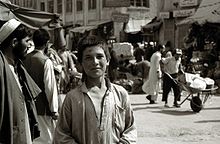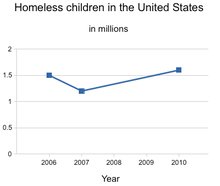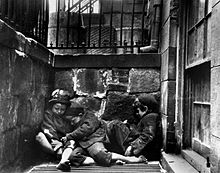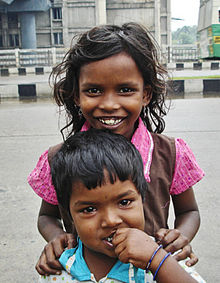
Street children
About this schools Wikipedia selection
SOS Children produced this website for schools as well as this video website about Africa. SOS mothers each look after a a family of sponsored children.
Street children is a term for children experiencing homelessness who primarily reside on the streets of a city. Homeless youth are often called street kids and street youth; the definition of street children is contested, but many practitioners and policymakers use UNICEF’s concept of boys and girls, aged under eighteen years, for whom "the street" (including unoccupied dwellings and wasteland) has become home and/or their source of livelihood, and who are inadequately protected or supervised (Black, 1993).
Some street children, notably in more developed nations, are part of a subcategory called thrownaway children who have been forced to leave home. Thrownaway children are more likely to come from working class and single parent homes. Street children are often subject to abuse, neglect, exploitation, or, in extreme cases, murder by " clean-up squads" that have been hired by local businesses or police. In Western societies, such children are sometimes treated as homeless children rather than criminals or beggars.
Definitions

Street children is used as a catch-all term, but covers children in a wide variety of circumstances and with a wide variety of characteristics. Policymakers and service providers struggle to describe and assist such a sub-population. Individual girls and boys of all ages are found living and working in public spaces, and are visible in the great majority of the world’s urban centers.
Statistics and distribution
Street children can be found in a large majority of the world's cities, with the phenomenon more prevalent in densely-populated urban hubs of developing or economically unstable regions, such as countries in Africa, Eastern Europe, and Southeast Asia.
According to a report from the Consortium for Street Children, a United Kingdom-based consortium of related non-governmental organizations (NGOs), UNICEF estimated that 100 million children were growing up on urban streets around the world. Fourteen years later, in 2002, UNICEF similarly reported, "The latest estimates put the numbers of these children as high as 100 million" (UNICEF, 2002: 37). More recently the organization added, "The exact number of street children is impossible to quantify, but the figure almost certainly runs into tens of millions across the world. It is likely that the numbers are increasing" (UNICEF, 2005: 40-41). The 100 million figure is still commonly cited for street children, but has no basis in fact (see Ennew and Milne, 1989; Hecht, 1998; Green, 1998). Similarly, it is debatable whether numbers of street children are growing globally, or whether it is the awareness of street children within societies that has grown.
History
The phenomenon of street children has been documented as far back as 1848. Alan Ball, in the introduction to his book on the history of abandoned children, And Now My Soul Is Hardened: Abandoned Children in Soviet Russia, 1918–1930, states:
Orphaned and abandoned children have been a source of misery from earliest times. They apparently accounted for most of the boy prostitutes in Augustan Rome and, a few centuries later, moved a church council of 442 in southern Gaul to declare: “Concerning abandoned children: there is general complaint that they are nowadays exposed more to dogs than to kindness.” In Tsarist Russia, seventeenth-century sources described destitute youths roaming the streets, and the phenomenon survived every attempt at eradication thereafter. "And Now My Soul Is Hardened". content.cdlib.org. Retrieved 2008-02-05.
By 1922 there were at least seven million homeless children in Russia due to the devastation from World War I and the Russian Civil War. Abandoned children formed gangs, created their own argot, and engaged in petty theft and prostitution. In 1848, Lord Ashley referred to more than 30,000 "naked, filthy, roaming lawless and deserted children" in and around London, UK.
Causes
The causes of this phenomenon are varied, but are often related to domestic, economic, or social disruption; including, but not limited to, poverty, breakdown of homes and/or families, political unrest, acculturation, sexual, physical or emotional abuse, domestic violence, lured away by pimps or internet predators, mental health problems, substance abuse, and sexual orientation or gender identity issues. Children may end up on the streets due to cultural factors. For example, some children in parts of Congo and Uganda are made to leave their family because they are suspected to be witches who bring bad luck upon their family. In Afghanistan, young girls who perform "honour crimes" that shame their family and/or cultural practices—like adultery (which may include rape or sexual abuse) or who refuse an arranged marriage—may be forced to leave their homes. In the United States, 100% of homeless women have experienced domestic or sexual violence.
By country
Asia
India
India has an estimated one million or more street children in each of the following cities: New Dehli, Kolkata, and Mumbai. It is more common for street children to be male and the average age is fourteen. The Republic of India is the seventh largest and second-most populated country in the world. Due to the acceleration in economic growth, an economic rift has appeared, with just over thirty-two per cent of the population living below the poverty line. Owing to unemployment, increasing rural-urban migration, the attraction of city life, and a lack of political will, India has developed one of the largest child labor forces in the world.
Indonesia
According to a 2007 study, there were over 170,000 street children living in Indonesia. In 2000, about 1,600 children were living on the streets of Yogyakarta. Approximately 500 of these children were girls from the ages of 4–16 years of age. Many children began living on the streets after the 1997 financial crisis in Indonesia. Girls living on the street face more difficulties than boys living on the street in Indonesia. Girls on the street are often abused by the street boys because of the patriarchal nature of the culture. "They abuse girls, refuse to acknowledge them as street children but liken them to prostitutes". Many girls become dependent on boyfriends; they receive material support in exchange for sex.
The street children in Indonesia are seen as a public nuisance. “They are detained, subjected to verbal and physical abuse, their means of livelihood (guitars for busking, goods for sale) confiscated, and some have been shot attempting to flee the police”.
Pakistan
The number of street children in Pakistan is estimated to be between 1.2 million and 1.5 million, meaning that the country has one of the world's largest street children populations. Past efforts have been initiated by UNICEF and other NGOs to assist children in need through various programs and rehabilitation centers; however, the situation remains as a prominent socio-economic issue in Pakistan in the 21st century.
The Philippines
According to the 1998 report, "Situation of the Youth in the Philippines", there are about 1.5 million street children in the Philippines, 70% of which are boys. Street children as young as ten years old can be imprisoned alongside adults under the Vagrancy Act; in past cases, physical and sexual abuse have occurred as a result of this legislation.
Vietnam
According to The Street Educators’ Club, the number of street children in Vietnam has shrunk from 21,000 in 2003 to 8,000 in 2007. The number dropped from 1,507 to 113 in Hanoi and from 8,507 to 794 in Ho Chi Minh City. There are currently almost 400 humanitarian organizations and international non-governmental organizations providing help to about 15,000 Vietnamese children.
Europe
Greece
Greece’s street child activity is heavily connected with human trafficking, especially with immigrants from Albania. In 2003, street children located in state-run facilities had disappeared. The disappearance is suspected to be linked to human trafficking. The numbers have decreased in recent years and Greece has taken “legislative action to criminalize human trafficking and related crimes”, though Amnesty International reports that the problem still exists and there is a failure of government protection and justice of trafficked children.
Begging and other street activities have been outlawed in Greece since 2003, but the recent unemployment hike has increased levels of these actions.
There are few programs for displaced children in Greece, which created a street child problem in the early 2000s. Giving foster parents to special needs children is not something the Grecian government has done, leading to higher numbers of physically or mentally disabled street children. There are also deterrents for working and poor parents in Greece making them more willing to force their children to the streets. For example, orphans are given financial benefits, but if they live in state-run facilities they cannot receive these benefits. For working parents to get government subsidies, they often have to have more than one child.
Romania
A 2000 report from the Council of Europe estimated that there were approximately 1,000 street children in the city of Bucharest. The prevalence of street children has led to a burgeoning sex tourism business in Romania; although efforts have been made to decrease the number of street children in the country.
Russia
In Russia there were about 7500 homeless street children in 2003, decreased to 4270 in 2005. By the end of 2011 the number of street children made 5266 kids. The number of Russian children that once lost their parents' support by the end of 2011 was 654,355. This includes 522,802 kids being on fostergage or adopted, and 105,688 kids in orphanages.
Latin America
According to some estimates, there are forty million street children in Latin America, most of whom work on the streets, but they do not necessarily live on the streets . A majority of the street children in Latin America are males between the ages of 10 and 14. There are two categories of street children in Latin America: home-based and street-based. Home-based children have homes and families to return to, while street-based children do not. A majority of street children in Latin America are home-based.
Brazil
The Brazilian government estimates that the number of children and adolescents who work or sleep on the streets is approximately 23,973, based on results from the national census mandated by the Human Rights Secretariat of the Presidency (SDH) and the Institute for Sustainable Development (Idesp).
Middle East
Turkey
1,641 street children are estimated in Turkey, mainly in İstanbul. Street children are most present in the eastern part of the country. Diyarbakır is one of the eastern cities where most of Turkey's remaining street children live.
North America
United States
An “estimated two million [youth] run away from or are forced out of their homes each year” in the United States. 1.6 million youth are currently homeless. The difference in these numbers can be attributed to the temporary nature of street children in the United States, unlike the more permanent state in developing countries.
Street children in the United States tend to stay in the state, 83% do not leave their state of origin. If they leave, street children are likely to end up in large cities, notably New York City, Los Angeles, Portland, Oregon, and San Francisco. Street children are predominantly Caucasian and female in the United States, and 42% identify as lesbian, gay, bisexual, or transgender ( LGBT).
The United States government has been making efforts since the late 1970s to accommodate this section of the population. The Runaway and Homeless Youth Act of 1978 made funding available for shelters and funded the National Runaway Switchboard. Other efforts include the Child Abuse and Treatment Act of 1974, the National Child Abuse and Neglect Data System, and the Juvenile Justice and Delinquency Detention Act. There has also been a decline of arrest rates in street youth, dropping in 30,000 arrests from 1998 to 2007. Instead, the authorities are referring homeless youth to state-run social service agencies.
Government and non-government responses
Responses by governments
While some governments have implemented programs to deal with street children, the general solution involves placing the children into orphanages, juvenile homes, or correctional institutions. Efforts have been made by various governments to support or partner with non-government organizations.
Public approaches to street children
There are four categories of how societies deal with street children: Correctional model, Rehabilitative model, Outreach strategies, and Preventive approach.
- The Correctional model is primarily used by governments and the police. They view children as a public nuisance and risk to security of the general public. The objective of this model would be to protect the public and help keep the kids away from a life of crime. The methods this model uses to keep the children away from the life of crime are the juvenile justice system and specific institutions.
- The Rehabilitative model is supported by churches and NGOs. The view of this model is that street children are damaged and in need of help. The objective of this model is to rehabilitate children into mainstream society. The methods used to keep children from going back to the streets are education, drug detoxification programs, and providing children with a safe family-like environment.
- The Outreach strategy is supported by street teachers, NGOs, and church organizations. This strategy views street children as oppressed individuals in need of support from their communities. The objective of the Outreach strategy is to empower the street children by providing outreach education and training to support children.
- The Preventive approach is supported by NGOs, the coalition of street children, and lobbying governments. They view street children’s poor circumstances from negative social and economic forces. In order to help street children, this approach focuses on the problems that cause children to leave their homes for the street by targeting parents’ unemployment, poor housing campaign for children’s rights.
NGO responses
Non-government organizations employ a wide variety of strategies to address the needs and rights of street children. One example of NGO effort is "The Street Children‘s Day", launched by Jugend Eine Welt on January 31, 2009 to highlight the situation of street children. The "Street Children's Day" has been commemorated every year since its inception in 2009.
UNICEF: Differential between street children
Street children differ in age, gender, ethnicity, social class and these children have had different experiences throughout their lifetimes. UNICEF differentiates between the different types of children living on the street in three different categories: candidates for the street (street children who work and hang out on the streets), children on the streets (children who work on the street but have a home to go to at night), and children of the street (children who live on the street without family support).
Horatio Alger's book, Tattered Tom; or, The Story of a Street Arab (1871), is an early example of the appearance of street children in literature. The book follows the tale of a homeless girl who lives by her wits on the streets of New York, US. Other examples from popular fiction include Kim, from Kipling's novel of the same name, who is a street child in colonial India. Gavroche, in Victor Hugo's Les Misérables, Fagin's crew of child pickpockets in Oliver Twist, a similar group of child thieves in Funke's The Thief Lord, and Sherlock Holmes' " Baker Street Irregulars" are other notable examples of the presence of street children in popular works of literature.





